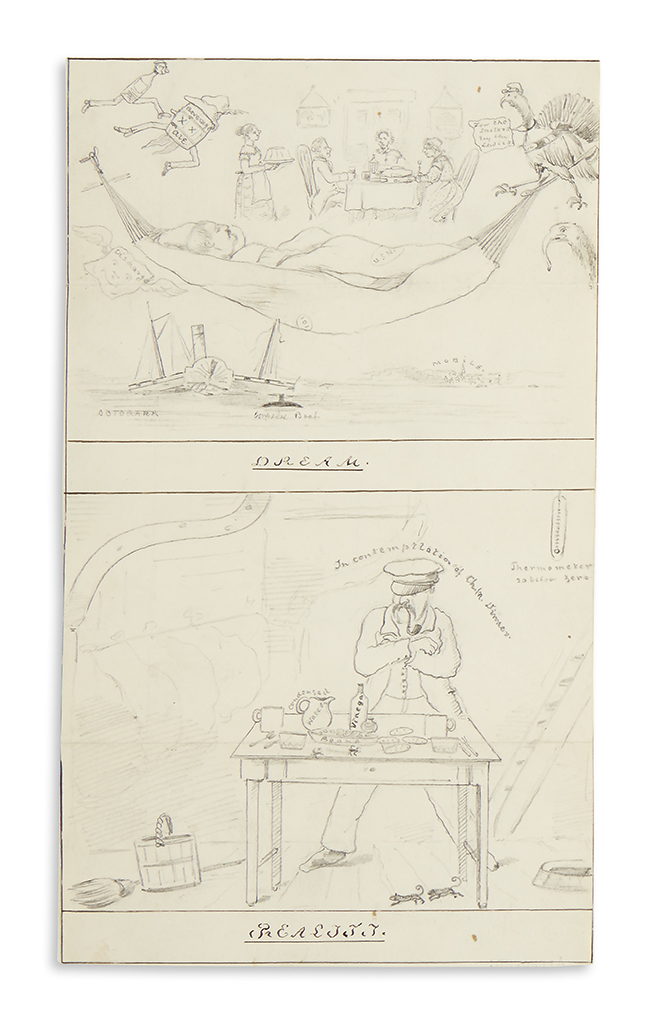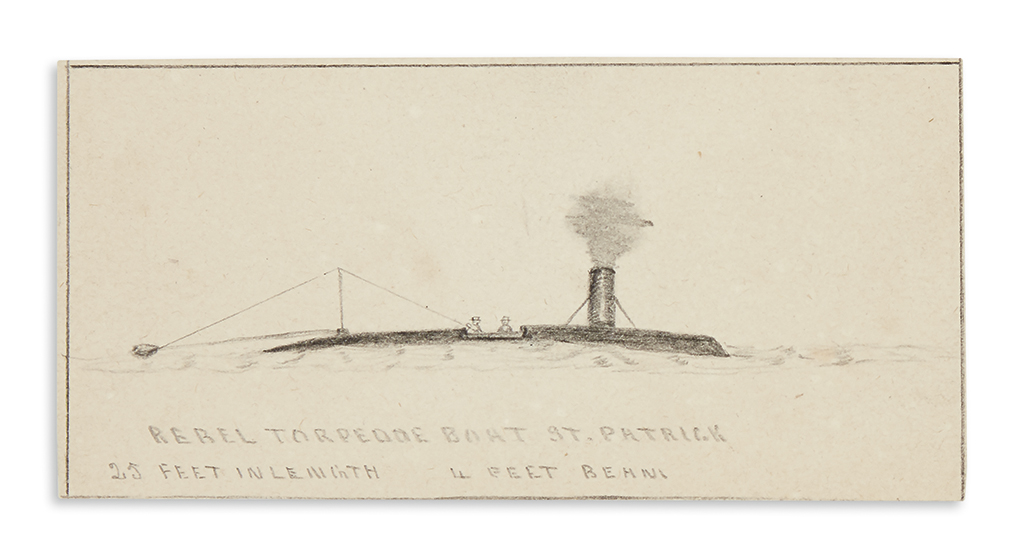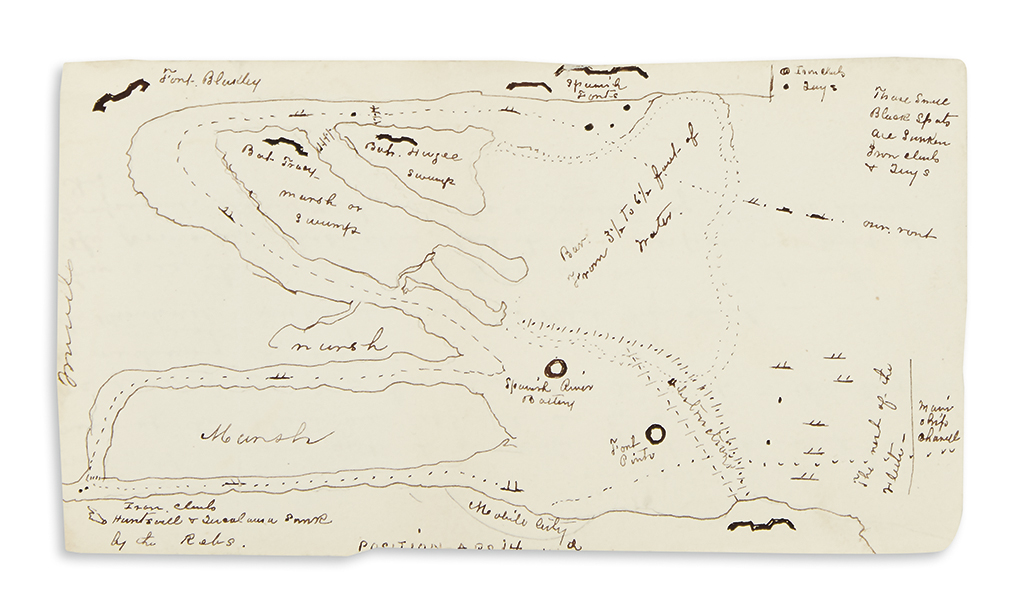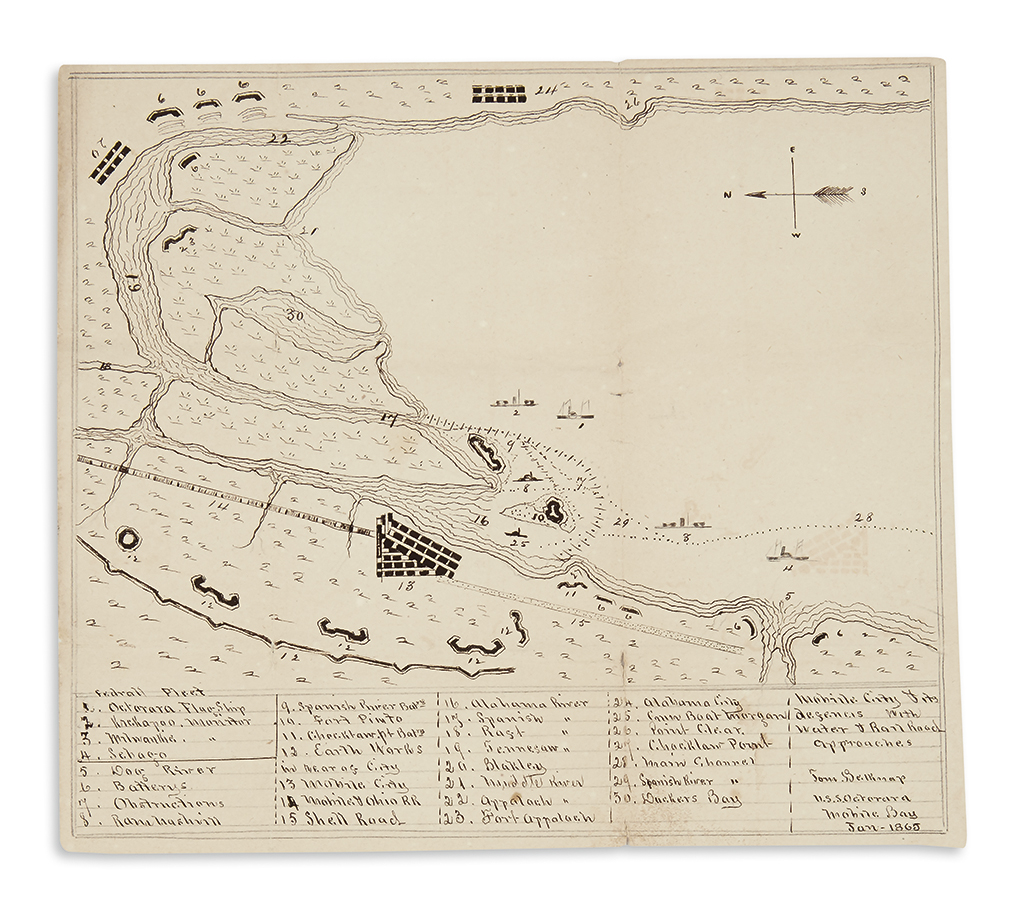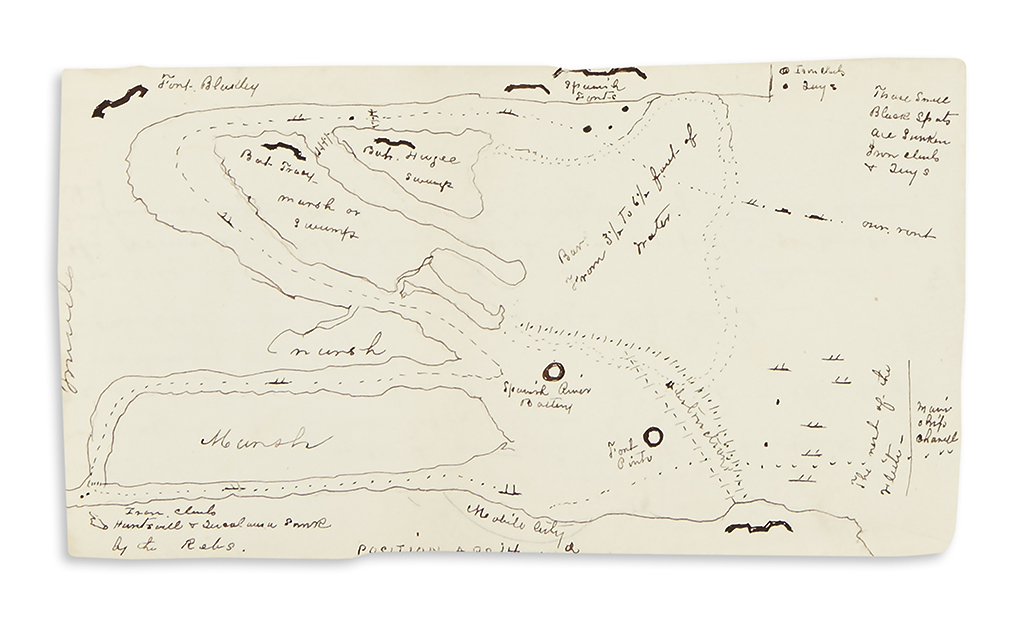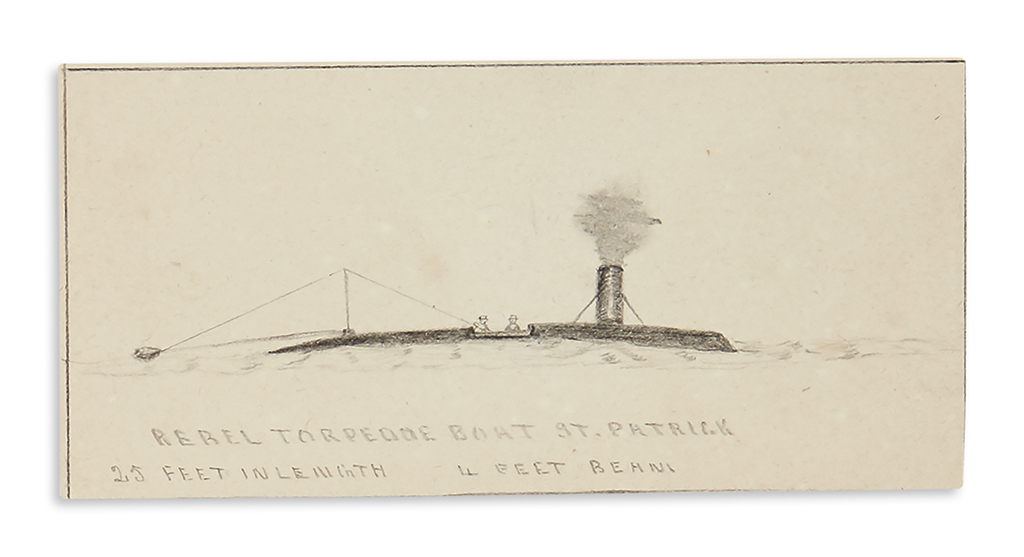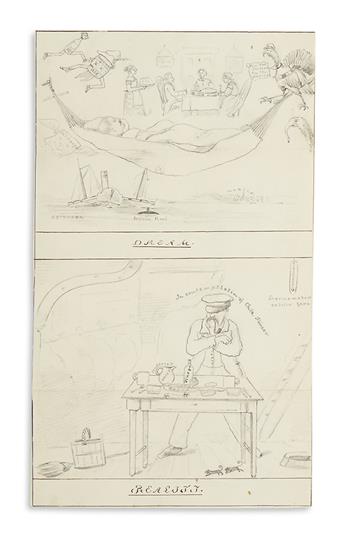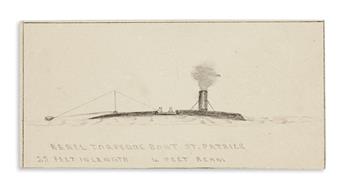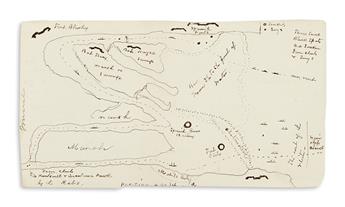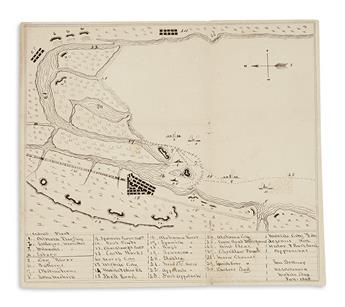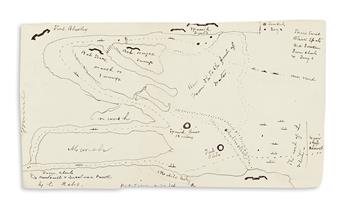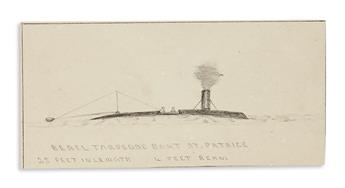Sale 2473 - Lot 71
Price Realized: $ 3,200
Price Realized: $ 4,000
?Final Price Realized includes Buyer’s Premium added to Hammer Price
Estimate: $ 6,000 - $ 9,000
(CIVIL WAR--NAVY.) Belknap, Thomas. Group of letters and drawings done aboard the USS Octorara in Mobile Bay. 5 Autograph Letters Signed to his father, sister, and friend Mark, various sizes and conditions * 2 pencil drawings * and 2 manuscript maps of Mobile Bay, 8 x 9 inches and 3 x 5 inches; condition generally strong, minor foxing and wear, with the 2 January 1865 letter defective and lacking some text. With transcripts of all letters. Off Mobile, AL, September 1864 to May 1865
Additional Details
These letters by Thomas Belknap (1835-1872) of the steamer USS Octorara were written in the months following the Union victory at the Battle of Mobile Bay. Mobile had not surrendered, but the Union Navy maintained a tight blockade. In the first letter on 24 September 1864, Belknap describes the surviving Confederate defenses. In addition to forts and batteries and a fleet of three ironclads, "the obstructions consist of sunken vessels and piles driven down so their tops are below the surface of the water some three or four feet, and having in their tops bars of iron sharpenel so as to penetrate any wooden ship that should attempt the passage. . . . The place is well-defended." The Confederates are also "strewing the channels with that most cowardly weapon of war, torpedos, in which they seem to have a great deal of faith since the sinking of the monitor Tecumseh." The Octorara is regularly taking in "deserters & refugees . . . black & white, male & female, kind of an assortment of colors & sexes."
The 7 January 1865 letter offers Belknap's "State of the Union" summary and local news. The USS Narcissus, "which the Johnnies so kindly sunk for us with a torpedoe, has been raised and is now undergoing repairs." He also regretted the poor quality of his Christmas dinner: "We waited & waited in vain for the appearance of the advance guard of the turky brigade, but nary a turky or turky's wife did this youth see. It is many a long day since I had the pleasure of putting my mastications in the plump leg of a gobler." Belknap enclosed with this letter an amusing cartoon captioned "Dream / Reality." He lays in his bunk while turkeys, ale and his discharge papers fly about his head, while the Octorara steams past an ominous torpedo boat. Reality was repersented by a scowling mess cook laying out a table of bread, vinegar, vermin, and "condensed water."
The 1-3 February 1865 letter describes the Octorara's encounter with a torpedo boat: "One of the lookouts stationed aft discovered some dark object on the surface of the water which through the darkness resembled one of the many dugouts or canoes which the refugees are in the habit of coming off to our ship nightly in. . . . In a moment the boat struck us right about the after gangway, but by some stroke of good fortune the torpedoe failed to expload. . . . One of our sailors boldley jumped down on the gangway ladder and seized the torpedoe boat with both hands by the smoke stack braces and partly careened her over." The boat made its escape without causing any damage. "We presume it is the one that the Johnnies call the St. Patrick. She is twenty-five feet in length, four feet beam, partly segar shape, made by iron, bullet-proof & generally carries three men." A sketch of the St. Patrick in the water, 2 1/4 x 4 1/2 inches, with its deadly cargo hung from a pole at its front, is included on a separate slip of paper.
The final letter in the collection is dated 28 May 1865, after the fighting had ended. Belknap describes a massive explosion in an arsenal which had flattened much of Mobile's harbor three days previously: "Our ship was laying within 300 yards of the building in the stream directly opposite to it. The force of the concussion knocking down the largest part of those on land, at the same time the air was filled with exploading shells. At one time I should judge there where at least five hundred shells exploading over and around our ship. . . . From a half to a mile from the explosion there is hardly a building but what has suffered damage. . . . Thousands of men worked hour after hour among the debris, and brought forth one after another of the writhing and dead victims, some had legs blown off, some an arm, some with heads cracked and some in such a condition as to present anything but the semblance of human beings."
This lot also includes two of Belknap's sketches of Mobile Bay, and a photograph of a third. One dated January 1865 is titled "Mobile Bay & its Defences, with Water and Railroad Approaches," and includes a key with 30 points described, including the location of each ship in the Union fleet. As a whole, an eventful and visually appealing record of the Union blockade of Mobile.
The 7 January 1865 letter offers Belknap's "State of the Union" summary and local news. The USS Narcissus, "which the Johnnies so kindly sunk for us with a torpedoe, has been raised and is now undergoing repairs." He also regretted the poor quality of his Christmas dinner: "We waited & waited in vain for the appearance of the advance guard of the turky brigade, but nary a turky or turky's wife did this youth see. It is many a long day since I had the pleasure of putting my mastications in the plump leg of a gobler." Belknap enclosed with this letter an amusing cartoon captioned "Dream / Reality." He lays in his bunk while turkeys, ale and his discharge papers fly about his head, while the Octorara steams past an ominous torpedo boat. Reality was repersented by a scowling mess cook laying out a table of bread, vinegar, vermin, and "condensed water."
The 1-3 February 1865 letter describes the Octorara's encounter with a torpedo boat: "One of the lookouts stationed aft discovered some dark object on the surface of the water which through the darkness resembled one of the many dugouts or canoes which the refugees are in the habit of coming off to our ship nightly in. . . . In a moment the boat struck us right about the after gangway, but by some stroke of good fortune the torpedoe failed to expload. . . . One of our sailors boldley jumped down on the gangway ladder and seized the torpedoe boat with both hands by the smoke stack braces and partly careened her over." The boat made its escape without causing any damage. "We presume it is the one that the Johnnies call the St. Patrick. She is twenty-five feet in length, four feet beam, partly segar shape, made by iron, bullet-proof & generally carries three men." A sketch of the St. Patrick in the water, 2 1/4 x 4 1/2 inches, with its deadly cargo hung from a pole at its front, is included on a separate slip of paper.
The final letter in the collection is dated 28 May 1865, after the fighting had ended. Belknap describes a massive explosion in an arsenal which had flattened much of Mobile's harbor three days previously: "Our ship was laying within 300 yards of the building in the stream directly opposite to it. The force of the concussion knocking down the largest part of those on land, at the same time the air was filled with exploading shells. At one time I should judge there where at least five hundred shells exploading over and around our ship. . . . From a half to a mile from the explosion there is hardly a building but what has suffered damage. . . . Thousands of men worked hour after hour among the debris, and brought forth one after another of the writhing and dead victims, some had legs blown off, some an arm, some with heads cracked and some in such a condition as to present anything but the semblance of human beings."
This lot also includes two of Belknap's sketches of Mobile Bay, and a photograph of a third. One dated January 1865 is titled "Mobile Bay & its Defences, with Water and Railroad Approaches," and includes a key with 30 points described, including the location of each ship in the Union fleet. As a whole, an eventful and visually appealing record of the Union blockade of Mobile.
Exhibition Hours
Exhibition Hours
Aliquam vulputate ornare congue. Vestibulum maximus, libero in placerat faucibus, risus nisl molestie massa, ut maximus metus lectus vel lorem.



